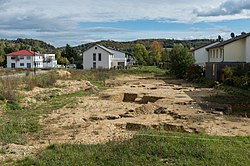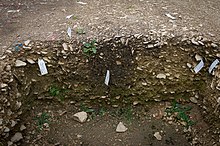Forsome
Coordinates: 48 ° 41 ′ 44.7 ″ N , 10 ° 9 ′ 39.5 ″ E
| Forsome | ||
|---|---|---|
| location | Baden-Wuerttemberg , Germany | |
| Location | Heidenheim - Schnaitheim | |
|
|
||
| When |
Linear ceramic tape , ≈ 5000 BC Chr. Urnfield culture , ≈ 1000-800 v. Chr. Hallstattzeit , ≈ 750-600 v. Chr. Latène period , ≈ 120 to 50 BC Chr. Roman Empire , ≈ 150 to 250 n. Chr. Alamannen time , ≈ 300 to 400 n. Chr. |
|
The Fürsamen is a winner in Heidenheim an der Brenz in Baden-Württemberg . Archaeological rescue excavations took place on the site between 1999 and 2017 ; the oldest finds date back to the Neolithic culture of linear ceramic . The settlement of the area during the Urnfield culture , in the Hallstatt and Latène times, as well as by Romans and Alemanni, could also be proven through numerous finds and findings . In the 4th century, Fürsamen was home to one of the largest known early Halemannic settlements in southern Germany.
Location and topography
The Fürsamen lies in the north of Heidenheim and borders on the southern outskirts of Schnaitheim . It has a slightly more than eight hectare, almost rectangular base area of about 570 meters in length. In the north, the width is around 170 meters; in the south, the eastern corner of the area is cut by a loop of the Brenz , reducing the width to around 70 meters. Starting in the north and looking clockwise, the Fürsamen borders the Baindt residential area , Johannes-Zimmermann-Weg , Im Fürsamen street and the Heidenheim-Aalen railway line . The zoning plan provides for residential development for the southern half of the area , the northern half will continue to be used for agriculture .
Due to its proximity to the Brenz river and its somewhat elevated position on the slightly rising right side of the valley, the Fürsamen offered prehistoric and early historical people very good settlement conditions. In addition to direct access to fresh water and food, the area was also protected from flooding . In the Brenztal, important traffic routes in the direction of the Alpine foothills converged, and the regional bean and Dogger ore deposits can also be assumed to be a further location factor.
Research history
At the end of the 1990s, the city of Heidenheim designated the Fürsamen as a new residential area . On the opposite shore in Brenz goods Seewiesen 1974-1983 already several Hallstatt tumuli have been excavated, further evidence of prehistoric settlement in the vicinity were considered likely. The State Monuments Office therefore had several search cuts created in the planned first construction phase in November 1998 . Because of the high density of findings encountered, archaeological excavation campaigns were repeated from 1999 onwards. The sponsors were the State Office for Monument Preservation in the Stuttgart Regional Council and the city of Heidenheim. The studies were funded by the European Social Fund . At the end of 2017, the archeological field work in the Fürsamen stopped.
Findings and finds
Most of the findings are post holes , storage , roasting or waste pits, as well as trenches and discoloration. Many findings overlap or are in poor condition or only partially preserved due to deep plowing and erosion. As a result, the assignment of post holes to building floor plans or chronological classifications are difficult or impossible in some areas.
More than 20 urn and incendiary graves from the late Bronze Age have so far been documented in the Forsamen. Some of them contained vessels made of high-quality black ceramic with secondary additions and remains of bronze weapons ( hilted sword , knife). Fragments of two moon idols were found in a mine complex .
From Celtic time, the floor plans are more houses (Schwellbalkenbau, storage , pit house ) and three Bratgruben - so-called Polynesian Schweinebratereien - proved. In addition to shards of pottery with the typical decorations, glass arm rings and a five-point bronze scratch could be recovered.
In prehistoric and frühalamannischen findings large amounts were Schnürchen- or drop slag and charcoal caked Luppen obtained in Rennöfen in the smelting of iron ore traffic. Remnants of five of these ovens could be reconstructed as relatively small, formerly roofed dome ovens with a preliminary pit, which were fed via an attached shaft. The location of the racing furnaces in the middle of a settlement is unusual; they were usually built in the immediate vicinity of the ore deposits.
The remains of an 18 × 17 meter large, heated residential building with risalits made of stone are of Roman origin . A wooden house, a brick-built pottery furnace and a stone well are assigned to him. The adjoining, narrow, over 50 meter long trenches with post stand marks are interpreted as fences or hedges for enclosing horse paddocks. It is not clear whether it was a villa rustica or an outdoor area of the Heidenheim Fort a few hundred meters away . From the pottery kiln comes a brick with the stamp of the Ala Secunda Flavia Pia Fidelis Milliaria cavalry regiment stationed there until around 155–160 AD . Other Roman remains include not only zerscherbter, relief decorated Sigillata also a few fragments utility ceramics, two coins, a fibula , a fragment of a military diploma and probably made of red jasper made cameo depicting the gods Mars and Victoria .
Extensive traces of settlement from the early Halemannic period were found on the entire excavation area. In addition to the numerous longhouses made of wood and half-timbered construction , several pit houses and storage structures built on stilts have been identified. Almost all residential buildings were oriented with the long axis to the north. Handicraft activities are evidenced by utility ceramics, spindle whorls , several clay pits, racing ovens and large amounts of iron slag. Other finds include a three-layer comb , a hook pin made of bronze with a twisted square shaft and a coin of Constantius II. It is assumed that the Alemannic settlement existed for about 150 years and around 600 people lived there.
Web links
Prehistoric and early historical settlements in Heidenheim-Schnaitheim, “Fürsamen” information brochure from the State Office for Monument Preservation, December 2011 (PDF; 1.3 MB).
Individual evidence
- ↑ a b c Hardy Prison: Continuation of the rescue excavations in the early Halemannic settlement of Heidenheim-Schnaitheim, "Fürsamen" . In: Archaeological excavations in Baden-Württemberg 2015 . Konrad Theiss, Stuttgart 2016, p. 204-207 .
- ↑ a b c Peter Knötzele: News from the early Halemannic settlement “Fürsamen” between Heidenheim and Schnaitheim - continuation guaranteed . In: Archaeological excavations in Baden-Württemberg 2007 . Konrad Theiss, Stuttgart 2008, p. 170-175 .
- ↑ Hanns Dietrich: The Hallstatt period grave finds from the Seewiesen of Heidenheim-Schnaitheim (= research and reports on prehistory and early history in Baden-Württemberg. Volume 66). Konrad Theiss, Stuttgart 1998, p. 134.
- ↑ Beate Leinthaler: A rural settlement of the early Middle Ages near Schnaitheim, district Heidenheim (= material booklets for archeology in Baden-Württemberg. Issue 70). Konrad Theiss, Stuttgart 2003, pp. 16-19.
- ↑ Hanns Dietrich: The Hallstatt period grave finds from the Seewiesen of Heidenheim-Schnaitheim (= research and reports on prehistory and early history in Baden-Württemberg. Volume 66). Konrad Theiss, Stuttgart 1998, p. 149.
- ↑ a b c d e Peter Knötzele: Settlements from four epochs - first results of the archaeological excavation in the "Fürsamen" corridor near Heidenheim-Schnaitheim . In: Archaeological excavations in Baden-Württemberg 1999 . Konrad Theiss, Stuttgart 2000, p. 81, 82 .
- ↑ a b c d Hardy Prison: Findings from the urn field culture to the early Halemannic period from the "Fürsamen" in Heidenheim-Schnaitheim . In: Archaeological excavations in Baden-Württemberg 2016 . Konrad Theiss, Stuttgart 2017, p. 217-221 .
- ↑ a b c Peter Knötzele : News from the "Fürsamen". To continue the archaeological excavations in the early Halemannic settlement between Heidenheim and Schnaitheim . In: Archaeological excavations in Baden-Württemberg 2012 . Konrad Theiss, Stuttgart 2013, p. 223-227 .
- ↑ Gereon Balle, Gubtram Gassmann, Klaus Schenck: For the preliminary conclusion of the archaeological excavation in the prehistoric and early historical settlements of Heidenheim-Schnaitheim, corridor "Fürsamen" . In: Archaeological excavations in Baden-Württemberg 2000 . Konrad Theiss, Stuttgart 2001, p. 78-80 .
- ↑ a b Peter Knötzele: Roman bathing building sought - On the progress of the excavations in the early Halaman settlement between Heidenheim and Schnaitheim, won "Forsamen" . In: Archaeological excavations in Baden-Württemberg 2008 . Konrad Theiss, Stuttgart 2009, p. 193-197 .
- ↑ Guntram Gassmann: On iron smelting in Heidenheim-Schnaitheim - scientific investigations of the finds and reconstruction of the furnace systems . In: Archaeological excavations in Baden-Württemberg 1999 . Konrad Theiss, Stuttgart 2000, p. 83-86 .
- ↑ a b Markus Scholz: A military diploma fragment from Heidenheim-Schnaitheim, "Fürsamen" . In: Archaeological excavations in Baden-Württemberg 2004 . Konrad Theiss, Stuttgart 2004, p. 189, 190 .
- ↑ Markus Scholz: The equestrian fort Aquileia / Heidenheim - The results of the excavations 2000-2004 (= research and reports on the prehistory and early history in Baden-Württemberg. Volume 110). Konrad Theiss, Stuttgart 2009, p. 457.
- ↑ Hardy Prison: News from the “Fürsamen” in Heidenheim-Schnaitheim . In: Archaeological excavations in Baden-Württemberg 2014 . Konrad Theiss, Stuttgart 2015, p. 242-245 .
- ↑ Andreas Uitz: Heidenheimer Alemanni settlement bigger than ever assumed. Heidenheimer Zeitung, December 2, 2012, accessed on November 20, 2017 .
- ↑ Andreas Uitz: New riddles from the Alemannic time discovered. Heidenheimer Zeitung, November 2, 2014, accessed on November 20, 2017 .



